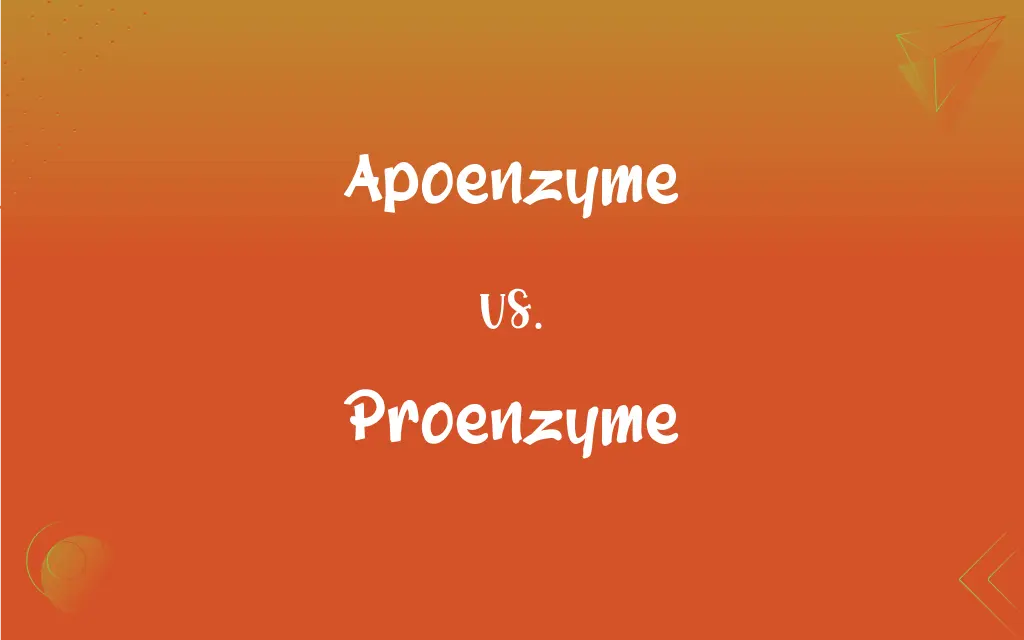Apoenzyme vs. Proenzyme: What's the Difference?
By Harlon Moss & Janet White || Updated on May 22, 2024
An apoenzyme is the inactive protein part of an enzyme, while a proenzyme is an inactive precursor of an enzyme that requires activation.

Key Differences
An apoenzyme is the protein component of an enzyme, which requires a cofactor to become active. It is specific in its function, binding with its cofactor to form a holoenzyme, which can then catalyze biochemical reactions. On the other hand, a proenzyme, or zymogen, is an inactive enzyme precursor that undergoes a biochemical change, typically cleavage, to become an active enzyme.
Apoenzymes are crucial for the specificity of enzyme activity because they provide the structural framework for the binding of cofactors and substrates. In contrast, proenzymes are important for regulating enzyme activity, ensuring that enzymes are activated only under appropriate conditions, thus preventing unwanted reactions within the cell.
The activation of an apoenzyme involves the binding of a cofactor, which can be a metal ion or an organic molecule, like a vitamin-derived coenzyme. The activation of a proenzyme, however, usually involves a proteolytic cleavage that removes an inhibitory segment, allowing the enzyme to assume its active conformation.
Apoenzymes without their cofactors are inactive and cannot perform catalytic activities. Proenzymes are synthesized in their inactive form to be activated later, providing a control mechanism for enzyme activity in metabolic pathways.
Apoenzymes play a role in the precise control of metabolic pathways by requiring specific cofactors for activity, whereas proenzymes serve as a protective mechanism, preventing premature or inappropriate enzyme activity that could damage the cell or tissue.
ADVERTISEMENT
Comparison Chart
Definition
Inactive protein part of an enzyme
Inactive precursor of an enzyme
Activation Requirement
Requires a cofactor
Requires biochemical change
Functionality
Forms active enzyme with cofactor
Becomes active enzyme post-cleavage
Role in Cell
Specific control of enzyme activity
Regulation and timing of enzyme activity
Mechanism
Cofactor binding
Proteolytic cleavage
ADVERTISEMENT
Apoenzyme and Proenzyme Definitions
Apoenzyme
Protein portion of an enzyme without its cofactor.
The apoenzyme by itself cannot catalyze the reaction.
Proenzyme
Inactive precursor of an enzyme.
The proenzyme was activated to start the digestive process.
Apoenzyme
Inactive protein part of an enzyme.
The apoenzyme required a cofactor to become catalytically active.
Proenzyme
Prevents premature enzyme activity.
The proenzyme safeguards against unwanted reactions in cells.
Apoenzyme
Specific in its function and binding.
The apoenzyme ensures precise substrate interaction.
Proenzyme
Synthesized in inactive form.
Proenzymes are produced in the pancreas and activated in the intestine.
Apoenzyme
Requires cofactor binding for activation.
An apoenzyme binds to its cofactor to form a functional enzyme.
Proenzyme
Often activated by proteolytic cleavage.
The conversion of the proenzyme into its active form involves removing a peptide segment.
Apoenzyme
Essential for enzyme specificity and regulation.
The apoenzyme's structure determines the enzyme's specificity.
Proenzyme
Requires biochemical change for activation.
The proenzyme underwent cleavage to become active.
Apoenzyme
The protein component of an enzyme, excluding additional components such as cofactors or inhibitors.
Proenzyme
The inactive or nearly inactive precursor of an enzyme, converted into an active enzyme by proteolysis. Also called zymogen.
Apoenzyme
(enzyme) An inactive haloenzyme lacking a cofactor.
Proenzyme
(biochemistry) Any inactive precursor of an enzyme that is converted to an enzyme by proteolysis; a zymogen
Apoenzyme
A protein that combines with a coenzyme to form an active enzyme
Proenzyme
Any one of a class of proteins that are converted, in the normal course of cellular metabolism, into one or more active enzymes; also called zymogen. The conversion usually is due to a specific cleavage of a peptide bond by another enzyme, or may be due to acid.
Proenzyme
Any of a group of compounds that are inactive precursors of enzymes and require some change (such as the hydrolysis of a fragment that masks an active enzyme) to become active
FAQs
What is a proenzyme?
A proenzyme, or zymogen, is an inactive precursor of an enzyme that requires a biochemical change for activation.
What is an apoenzyme?
An apoenzyme is the inactive protein part of an enzyme that requires a cofactor for activation.
Can an apoenzyme function without its cofactor?
No, an apoenzyme cannot function without its cofactor; it remains inactive.
What is the role of apoenzymes in enzymatic activity?
Apoenzymes provide the structural framework for binding cofactors and substrates, ensuring enzyme specificity.
Why are proenzymes synthesized in an inactive form?
Proenzymes are synthesized in an inactive form to regulate enzyme activity and prevent premature reactions.
How is a proenzyme activated?
A proenzyme is typically activated by proteolytic cleavage.
What happens during the activation of a proenzyme?
During activation, a proenzyme undergoes a biochemical change, often proteolytic cleavage, to become an active enzyme.
How does an apoenzyme become active?
An apoenzyme becomes active by binding to its specific cofactor.
What type of biochemical change activates a proenzyme?
Proteolytic cleavage is a common biochemical change that activates a proenzyme.
What is the importance of apoenzymes in metabolism?
Apoenzymes are crucial for the precise control of metabolic pathways by requiring specific cofactors.
How do proenzymes prevent unwanted enzyme activity?
Proenzymes prevent unwanted enzyme activity by being synthesized in an inactive form until needed.
What is a common cofactor for apoenzymes?
Common cofactors for apoenzymes include metal ions and organic molecules like vitamins.
Are apoenzymes active on their own?
No, apoenzymes are not active on their own; they need to bind to a cofactor.
What regulates the activation of proenzymes?
The activation of proenzymes is regulated by biochemical signals and changes, such as proteolytic cleavage.
What happens if an apoenzyme does not bind to its cofactor?
If an apoenzyme does not bind to its cofactor, it remains inactive and cannot catalyze reactions.
Do proenzymes require cofactors for activation?
Proenzymes do not require cofactors for activation; they require a biochemical change like cleavage.
Why are proenzymes important in digestion?
Proenzymes are important in digestion because they ensure enzymes are activated only in the appropriate environment, preventing damage to tissues.
What is an example of a proenzyme?
Pepsinogen is an example of a proenzyme, which is converted to pepsin in the stomach.
What is an example of an apoenzyme?
The protein part of lactase without its cofactor is an example of an apoenzyme.
What is the difference between an apoenzyme and a holoenzyme?
An apoenzyme is the inactive protein part of an enzyme, while a holoenzyme is the active enzyme with its cofactor.
About Author
Written by
Harlon MossHarlon is a seasoned quality moderator and accomplished content writer for Difference Wiki. An alumnus of the prestigious University of California, he earned his degree in Computer Science. Leveraging his academic background, Harlon brings a meticulous and informed perspective to his work, ensuring content accuracy and excellence.
Co-written by
Janet WhiteJanet White has been an esteemed writer and blogger for Difference Wiki. Holding a Master's degree in Science and Medical Journalism from the prestigious Boston University, she has consistently demonstrated her expertise and passion for her field. When she's not immersed in her work, Janet relishes her time exercising, delving into a good book, and cherishing moments with friends and family.































































